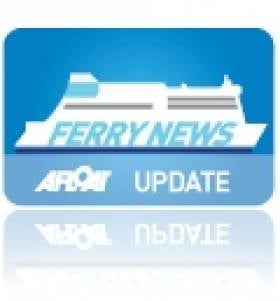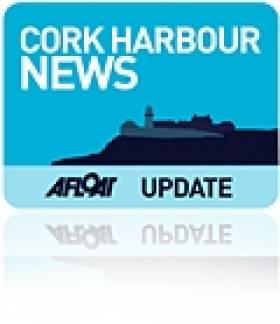Displaying items by tag: Whale of a Time
Ferries Great and Small during Cork Harbour Open Weekend
#FERRY NEWS – Coinciding with Cork Harbour Open Weekend, will be the regular departure today of Brittany Ferries 'flagship' Pont-Aven (2004/41,748grt). The cruiseferry which features an indoor swimming pool, is scheduled to depart later this afternoon, writes Jehan Ashmore.
The cruiseferry operates on the shortest Irish-French route, taking 14 hours to reach the Breton port of Roscoff. The ferry only calls to Cork (Ringaskiddy) on Saturday's, on the seasonal-service which is to cease sailings in November. Currently the company has a single fare from €70 per person based on a car plus four passengers including a 4-berth inside cabin, for information click HERE.
While on a domestic front, services running within the waters of the natural harbour, are provided by Cork Harbour Cruises, where the tender Spirit of the Isles runs between Cork City centre downriver to Cobh. In September, sailings depart Cork at 11am (Saturdays and Sundays). The operator also provides tours beyond Cobh and a Spike Island tour. For details visit: www.corkharbourcruises.ie/tours.php
During the Cork Harbour Open Weekend, there will be free ferry (RIB based) shuttle services run by Whale of A Time, which will serve on a circuit throughout the lower harbour (on both days 12noon-3pm), for further details click HERE.
Road, Rail or ‘Sail’ to Cobh
There's also the option of departing Cork-city centre to Cobh by taking an excursion on the River Lee on the passenger-tender Spirit of the Isles. Sailings depart the city's Penrose Quay, which is on the same side to the railway (Kent) station.
Sailings will operate this Saturday and Sunday and for the remaining weekends throughout September. The boat's Saturday schedule departs the city at 11am and arrives at Cobh's Kennedy Quay at 12.15pm.
In addition there is a Lower harbour tour off Cobh on Saturdays and Sundays, departing Kennedy Pier, Cobh - 12.30pm and returning to Kennedy Pier at 1.45pm. The boat then departs Cobh at 2pm to return to Cork with an arrival time of 3.15pm. For both this Saturday and Sunday sailing schedules, fares and further information go to www.corkharbourcruises.com
In the late 1980's the Spirit of the Isles then named Ingot operated excursions for several seasons from Dun Laoghaire's East Pier to Dalkey Sound and Killiney Bay.
Returning to the third annual Cork Harbour Open Day there will also be a free shuttle-service running in the lower harbour calling at Ringaskiddy, Monkstown, Cobh, Aghada and Crosshaven. The fast-ferry RIB operator 'Whale of a Time' is providing the free service which is sponsored by the Port of Cork Company and National Maritime College of Ireland (NMCI). For further information visit http://www.whaleofatime.net/Home.html
- Dun Laoghaire
- Cork Harbour
- port of Cork
- Cruise Liners
- River Lee
- Cork Harbour Open Day
- NMCI
- Cobh Cruise Terminal
- National Maritime College of Ireland (NMCI)
- Ports and Shipping News
- Cork Harbour News
- Irish Rail
- Port of Cork Company
- Cunard Line
- Queen Elizabeth
- Whale of a Time
- Cruise Liner news
- Dalkey Sound
- Cruise ship news
- Midelton Food & Drink Festival
- Ingot
- Killiney Bay
- Irish passenger excursion vessels
- Cork Harbour Cruises
- CorkCobh
- Cork (Kent) station
- Spirit of the Isles
Video of Basking Shark Tagging
Cork-based boat charter firm Whale of a Time has posted video on its YouTube channel of the Irish Whale and Dolphin Group (IWDG) tagging a basking shark from its boat Mischief:
Apart from whales, basking sharks are the largest species of marine wildlife to frequent Irish waters.
































































